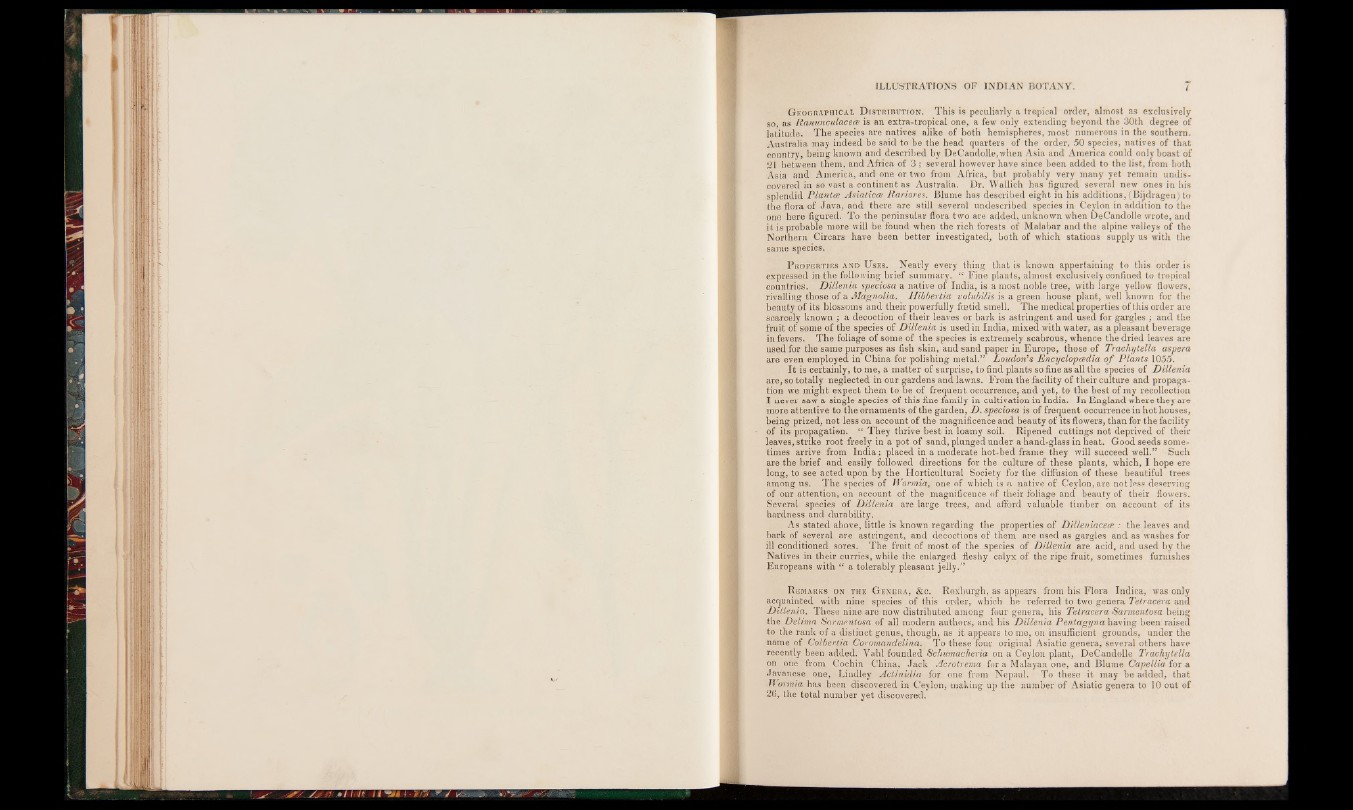
G eographical D istribution. This is peculiarly a tropical order, almost as exclusively
so, as Ranunculacece is an extra-tropical one, a few only extending beyond the 30th degree of
latitude. The species are natives alike of both hemispheres, most numerous in the southern.
Australia may indeed be said to be the head quarters of the order, 50 species, natives of that
country, being known and described by DeCandolle,when Asia and America could only boast of
21 between them, and Africa of 3 ; several however have since been added to the list, from both
Asia and America, and one or two from Africa, but probably very many yet remain undiscovered
in so vast a continent as Australia. Dr. Wallich has figured several new ones in his
splendid Plantce Asiaticce Rariores. Blume has described eight in his additions, (Bijdragen) to
the flora of Java, and there are still several undescribed species in Ceylon in addition to the
one here figured. To the peninsular flora two are add$d, unknown when DeCandolle wrote, and
it. is probable more will be found when the rich forests of Malabar and the alpine valleys of the
Northern Circars have been better investigated, both of which stations supply us with the
same species.
P roperties and U ses. Nearly every thing that is known appertaining to this order is
expressed in the following brief summary. “ Fine plants, almost exclusively confined to tropical
countries. Dillenia speciosa a native of India, is a most noble tree, with large yellow flowers,
rivalling those of a Magnolia. Hibbertia volubilis is a green house plant, well known for the
beauty of its blossoms and their powerfully foetid smell. The medical properties of this order are
scarcely known ; a decoction of their leaves or bark is astringent and used for gargles ; and the
fruit of some of the species of Dillenia is used in India, mixed with water, as a pleasant beverage
in fevers. The foliage of some of the species is extremely scabrous, whence the dried leaves are
used for the same purposes as fish skin, and sand paper in Europe, those of Trachytella aspera
are even employed in China for polishing metal.” Loudon's Encyclopcedia o f Plants 1055.
I t is certainly, to me, a matter of surprise, to find plants so fine as all the species of Dillenia
are, so totally neglected in our gardens and lawns. From the facility of their culture and propagation
we might expect them to be of frequent occurrence, and yet, to the best of my recollection
.1 never saw a single species of this fine family in cultivation in India. In England where they are
more attentive to the ornaments of the garden, D . speciosa is of frequent occurrence in hot houses,
being prized, not less on account of the magnificence and beauty of its flowers, than for the facility
of its propagation. “ They thrive best in loamy soil. Ripened cuttings not deprived of their
leaves, strike root freely in a pot of sand, plunged under a hand-glass in heat. Good seeds sometimes
arrive from India; placed in a moderate hot-bed frame they will succeed well.” Such
are the brief and easily followed directions for the culture of these plants, which, I hope ere
long, to see acted upon by the Horticultural Society for the diffusion of these beautiful trees
among us. 1'he specie's of Wormia, one of which is a native of Ceylon, are not less deserving
of our attention, on account of the magnificence of their foliage and beauty of their flowers.
Several species of Dillenia are large trees, and afford valuable timber on account of its
hardness and durability.
As stated above, little is known regarding the properties of Dilleniacece : the leaves and
bark of several are astringent, and decoctions of them are used as gargles and as washes for
ill conditioned sores. The fruit of most of the species of Dillenia are acid, and used by the
Natives in their curries, while the enlarged fleshy calyx of the ripe fruit, sometimes furnishes
Europeans with “ a tolerably pleasant jelly.”
R emarks on the G enera, &c. Roxburgh, as appears from his Flora Indica, was only
acquainted with nine species of this order, which he referred to two genera Tetracera and
Dillenia. These nine are now distributed among four genera, his Tetracera Sarmentosa being
the Delima Sarmentosa of all modern authors, and his Dillenia Pentagyna having been raised
to the rank of a distinct genus, though, as it appears to me, on insufficient grounds, under the
name of Colbertia Coromandelina. To these four original Asiatic genera, several others have
recently been added. Vahl founded Schumacheria on a Ceylon plant, DeCandolle Trachytella
on one from Cochin China, Jack Acrotrema for a Malayan one, and Blume Capellia for a
Javanese one, Lindley Actinidia for one from Nepaul. To these it may be added, that
Wormia has been discovered in Ceylon, making up the number of Asiatic genera to 10 out of
26, the total number yet discovered.